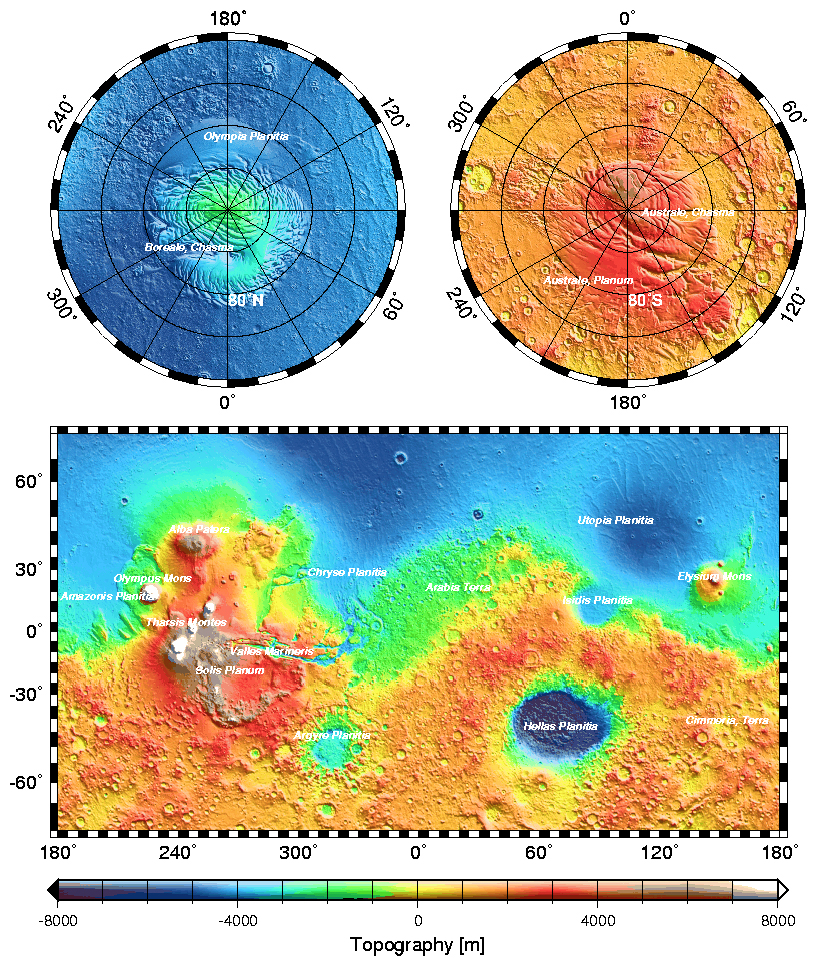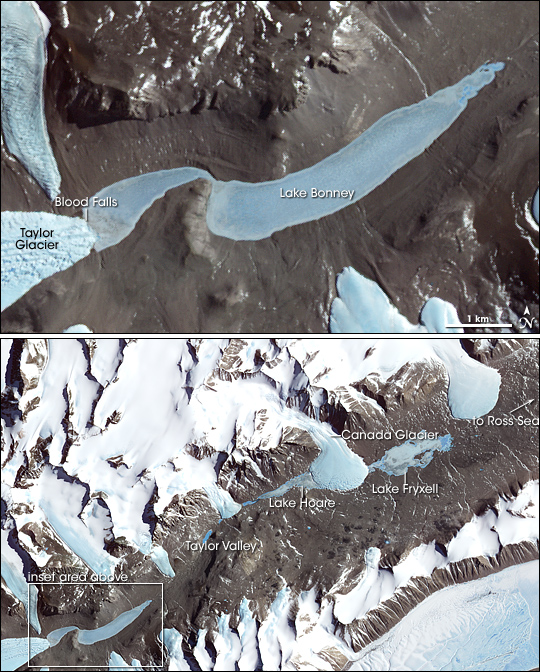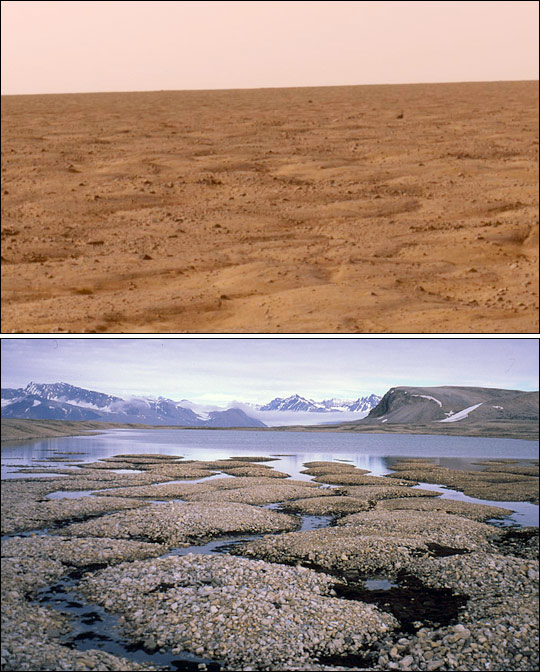Earth and Mars: Twins or Siblings?

An astronomer called Cervantes
July 1, 2014The intensive exploration of Mars is yielding a large amount of data about its properties and its past. However, two great enigmas are yet to be explained: what caused this planet to be different from planet Earth? Is there or has there been any biological activity on the Red Planet? Particularly revealing is the comparative study of both planets.
From a distance, the Earth and Mars show some striking differences. In the first case, the prevailing colors are white and blue, corresponding to clouds and the oceans, and the brown shades of the continents. Thus, the existence of water in its various states (solid in the polar icecaps, liquid in the oceans and seas, and gaseous in the atmosphere) is evident. And the presence of water almost immediately suggests the existence of life. In fact, even from orbiting satellites it is possible to notice the planet’s intense biological activity, as is the case of the Antarctic sea ice or the seasonal change of the forest lands.

The Earth (the first full photograph of the planet, taken from Apollo 17, with the Antarctica at the top) and Mars (image taken by the HST). Note that they are not scaled, as Mars is considerably smaller than our planet (the equatorial diameters are 12,756.28 and 6,794.4 kilometers, respectively).
Mars is quite different. Various shades of orange, caused by iron oxide, prevail on its surface. Depending on the season and the position relative to the Earth, a pole can be visible, although on this occasion the white color essentially denotes dry ice (solid carbon dioxide). However, several studies conducted in recent years have made it clear that there is water on Mars and that the dynamics of this compound is quite complex.
Mars has a thin atmosphere consisting essentially of carbon dioxide (95.32%), nitrogen (2.7%), argon (1.4 %) and traces of oxygen (0.13%). By contrast, the Earth’s atmosphere consists essentially of nitrogen (78.1 %), oxygen (20.94%), argon (0.93%) and a variable amount of carbon dioxide (around 0.035%, and increasing quickly). The average temperatures vary greatly: -55 degrees Celsius (ºC) in the case of Mars, with lows of around -133 ºC and highs of some +27 ºC; and an average of around +15 ºC in the case of the Earth, with lows of -89.4 ºC (in Vostok, the Antarctica, although temperatures of -93.2 ºC have been recorded recently nearby, in measurements taken by a satellite) and highs of +58 ºC or +56.7 ºC (in El Azizza, in Libya, or in Furnace Creek, in the U.S.). However, the Earth’s average temperature is affected by the greenhouse effect caused by gases in the atmosphere, mainly carbon dioxide, water vapor, ozone (molecules of oxygen with three atoms, instead of the two of the oxygen we breathe) and methane. Otherwise, the average temperature would be about 33 ºC lower, around -18 ºC, and therefore the water would be in solid state in most parts of the planet.
In the cases of Mars and the Earth, the internal structure is divided into three well-differentiated regions: crust, mantle and core. However, contrary to the Earth, Mars’ core is solid and does not create its own magnetic field. There are, however, local magnetic fields, “fossil” remains of a global field that may have existed as a result of a partially liquid core, as in the case of the Earth. The virtual absence of plate tectonics, as we know it on Earth, which causes strong volcanic activity and orogeny (mountain formation), means that Martian soil is much older than the Earth’s ocean floors and continents. For example, the great depression of the southern hemisphere, Hellas Planitia, was caused by the impact of a large celestial body some 3,900 million years ago. In the case of the Earth, evidence on the crust of an event like this would have ceased to exist a long time ago.
Figure 2: Diagram showing the topography of Mars, whose minimum (deep blue) and maximum heights (red-white) are found in a range of 16,000 kilometers. Note that Olympus Mons, the highest mountain in the Solar System, soars to a height of 21 kilometers above the level at which the pressure of the atmosphere is 6.1 millibar (the pressure at which the triple point of water is located), and which is called Mars datum (equivalent to the sea level on the Earth). Since the lowest point is found in Hellas Planitia (an old impact crater), at around 7 kilometers below the Mars datum, the difference is about 28 kilometers, significantly greater than the 18 kilometers that separate the depths of the Mariana Trench and the summit of Mount Everest. Credits: Mars Orbiter Laser Altimeter and NASA.

Diagram showing the topography of Mars, whose minimum (deep blue) and maximum heights (red-white) are found in a range of 16,000 kilometers. Note that Olympus Mons, the highest mountain in the Solar System, soars to a height of 21 kilometers above the level at which the pressure of the atmosphere is 6.1 millibar (the pressure at which the triple point of water is located), and which is called Mars datum (equivalent to the sea level on the Earth). Since the lowest point is found in Hellas Planitia (an old impact crater), at around 7 kilometers below the Mars datum, the difference is about 28 kilometers, significantly greater than the 18 kilometers that separate the depths of the Mariana Trench and the summit of Mount Everest. Credits: Mars Orbiter Laser Altimeter and NASA.
In any event, the comparison of the height profiles of both planets shows that they are very different: while most of the Earth’s continental land mass is concentrated in the northern hemisphere, which also lacks a polar continent, the northern hemisphere in Mars is dominated by the Vastitas Borealis depression, thousands of meters below the Mars datum. It is located at the height at which the pressure of the atmosphere is 6.1 millibar, where the triple point of water is found, defined as the point in the mass diagram (pressure versus temperature) at which a substance coexists in solid, liquid and gaseous state simultaneously. In the case of water, the exact values are 273.16 K (0.01 °C) at a pressure of 6.1173 millibar. Therefore, below the Mars datum (for example, the Hellas Planitia depths) it would be possible to find liquid water if the temperature were sufficiently high. Contrary to what happens in Mars, the Earth’s southern hemisphere is dominated by oceans and seas, although several continental masses that rise at considerable heights above sea level (such as the Antarctic Plateau) stand out in its topographic profile. The situation in Mars is more uniform. The greatest difference is the large amount of water in solid state concentrated on the Earth’s South Pole. It covers an area of some 14 million square kilometers in summer, but by including the sea ice it can expand to 30 million. In contrast, the size reached by the Martian Antarctica is much smaller, around 140,000 square kilometers, and its composition is very different since dry ice dominates, as mentioned earlier.
Curiously, in our Antarctica we find some of the closest similarities with Mars, namely low temperatures and reduced humidity. This is the case of the McMurdo valley system, located very near the coast, which geologically could have equivalents in Mars. Whether there is life or not, or there has ever been any biological activity, is still an open question. Some studies suggest that the Martian ground is too salty for life to have developed. However, in our own planet there are many examples of living creatures that develop in apparently hostile environments. These are known as extremophiles.

The McMurdo valleys in the Antarctica, near the coast. This system is usually free of snow and is extraordinarily dry. It could therefore be similar to certain Martian areas. Credits: NASA, Terra satellite and ASTER instrument.
Several spaceships shave successfully landed on Mars. One of the most recent, which landed further north, was the Phoenix Mars Lander in 2008. Its images revealed a plain covered with polygonal shapes that resemble those present in similar regions of the Earth. It is permafrost that solidifies and melts seasonally, a clear evidence of the presence of water on the planet. Phoenix had suitable instrumentation for drilling and analyzing these structures, including their chemical composition, to try to determine if any organic compounds (although not necessarily biological) are present on the Arctic plains of Mars. Later, the Curiosity rover landed near the equator in 2012. It is still in operation and has conducted many experiments, including rock drilling. In any case, we should remember that at least on our planet there are living creatures (the extremophiles) that can grow in truly amazing environments: from acidic media to submarine volcanic calderas at high temperatures. The Río Tinto ecosystem is a typical example. Unfortunately, it cannot be ruled out that some of the probes that have landed on the Red Planet may have contaminated it with biological material.
Yes, both planets have interesting similarities and great differences. We could describe Mars as the Earth’s poor relation. However, we have just scratched a few sites on its surface. Most of its secrets remain unknown to man.
The Earth’s surface, with the height shown color-coded: blue for ocean floors and green, yellow and red for the continents. The greatest depth, in the oceanic trenches, is around 11,000 meters below sea level (deeper blue). The deeper reds denote heights of 5,000 meters above sea level. The maximum height difference on our planet is about 19,000 meters.

A comparison between the Arctic plains on Mars (above), in a recent image taken by the American probe Phoenix Mars Lander, and the Earth (Spitsbergen, in the Svalbard archipelago in Norway, but located in the Arctic).
This text is an adapted summary of chapter 10 of the book “Visiones de Gaia: la Tierra desde el espacio” written by David Barrado and published by INTA (National Aerospace Technology Institute “Esteban Terradas”). To access the complete book in Spanish, click here. A bilingual, updated version of the article in English and Spanish in the open magazine by the BBVA Foundation.
David Barrado Navascués
Centro de Astrobiología, INTA-CSIC
European Space Astronomy Center (ESAC, Madrid)

